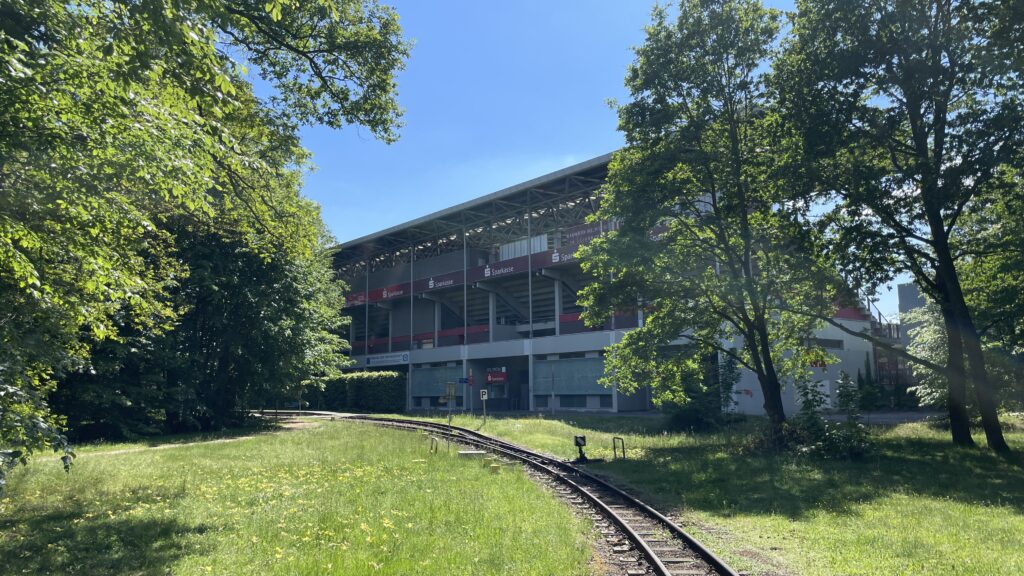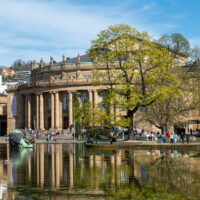Recently, Father’s Day was approaching, and as a family, we were considering how we could spend this day together. After a short brainstorming session, I suggested taking a trip to Cottbus. Although I had often used the RE2 train, which runs from Berlin through the heart of the city to Cottbus, I had never seriously considered actually traveling to Cottbus. Why would I? No one in my circle of friends is from that city, and a visit there was never considered. Even my father, who has lived in Berlin for almost 30 years and grew up in East Germany, had never been to Cottbus. Yet, the travel time with the RE2 is only an hour and a half. It’s almost like with Bielefeld: everyone knows the city, but no one has been there yet. So, you could say that Cottbus is the Bielefeld of the East.
Discoveries in Cottbus: A City of Surprises
So, on Thursday morning, we set off with packed backpacks and took the RE2 to Cottbus. To our surprise, the RE2 route passed right by Tropical Island. I knew you could go there by regional train, but the fact that the RE2 took this route and that it was less than an hour away from Berlin still surprised me. With a delay of less than 5 minutes, we arrived in Cottbus just before 11 a.m. The city, with almost 100,000 inhabitants, welcomed us with a surprisingly large main station. From here, regional trains depart regularly in various directions, as well as bus and tram connections, every hour. Here, you could already experience the “Deutschlandtakt” in the wild.
After leaving the main station, we set off on foot towards the old town. Passing by the State Theatre, we quickly caught sight of the Spremberg Tower, probably the landmark of Cottbus. The path led us along a shopping street, at the end of which stretched the Old Market Square. Here, in the heart of Cottbus, we found a large square with many cafes, restaurants, and some shops, perfect for a break. The buildings were very appealing both from the outside and the inside. Here, we treated ourselves to a delicious schnitzel with asparagus for lunch.




Cottbus: Cultural and Historical Highlights
Refreshed, we made our way to the IKMZ Cottbus, a university library. The library impressed not only with its exterior but also with the fact that four pieces of the Berlin Wall are exhibited here. I was really surprised because I knew some parts of the Berlin Wall had been taken away from Berlin. Like one piece that ended up in the NATO headquarters in Brussels. But I never thought Cottbus would have one too.


Nature and Culture in Branitzer Park, Cottbus
We continued our journey through the old town towards the south of Cottbus, more precisely to Branitzer Park. On the way, we passed the LEAG Energy Stadium, where FC Energie Cottbus plays its games. A club that played in the First and Second Bundesliga for several years but now competes in the Regionalliga Nordost. The parks leading to Branitzer Park were beautifully designed, and it was enjoyable to walk through them. Arriving at Branitzer Park, we were particularly struck by the Water Pyramid and Land Pyramid, which were built in the 19th century and now serve as the burial site of the prince and his wife.








A Cultural Diversity
Although one might not expect it, the language in this region of Germany is very diverse. In addition to German, a minority of up to 30,000 inhabitants speak Sorbian as well as various Sorbian dialects. Cottbus is located among the northernmost regions where Sorbian is spoken. This extends to Saxony, almost reaching the Czech border. Sorbian belongs to the group of West Slavic languages. This linguistic diversity is also reflected in the signage of cities, streets, and buildings, which are marked not only in German but also in Sorbian. This could be seen first in the regional train as the first stations before Cottbus or Chóśebuz were labeled in Lower Sorbian alongside German.
Critique of Public Transportation
One point that must be criticized, however, is the public transportation system. Although there appears to be a well-developed network of trams and buses, the frequency of services is often inadequate. For example, the bus from the zoo to the main train station ran only hourly. Additionally, most tram lines only operated every half an hour. This significantly limited our exploration options, as we were traveling solely on foot due to arriving with the RE2 train and not having access to public transport or a car.
Conclusion: Cottbus is Worthwhile
After a day full of discoveries and surprises in Cottbus, I can say that the city has more to offer than its reputation suggests. From historical landmarks like the Spremberger Tower to cultural treasures like the IKMZ and Branitzer Park as a calm oasis, Cottbus offers a diverse range of experiences. Although the public transportation system has room for improvement, a visit is worthwhile, even if just for a day trip, especially for those already living in the region. Initially, I went in with the expectation that Cottbus is the Bielefeld of the East. Now, having been to Cottbus, I can at least say that Cottbus might not be the Bielefeld of the East, as it obviously exists and even offers cultural diversity.





